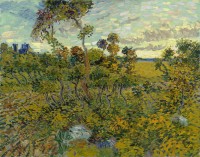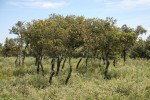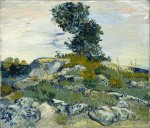 Amsterdam’s Van Gogh Museum has authenticated a new painting by Vincent van Gogh, the first full-sized canvas by the master to be found since 1928. It’s called Sunset at Montmajour, is 93.3 x 73.3 centimeters (36.73 x 28.86 inches) and was painted in the Arles area by van Gogh during the summer of 1888. Van Gogh Museum Director Axel Rüger explains the significance of the piece:
Amsterdam’s Van Gogh Museum has authenticated a new painting by Vincent van Gogh, the first full-sized canvas by the master to be found since 1928. It’s called Sunset at Montmajour, is 93.3 x 73.3 centimeters (36.73 x 28.86 inches) and was painted in the Arles area by van Gogh during the summer of 1888. Van Gogh Museum Director Axel Rüger explains the significance of the piece:
“A discovery of this magnitude has never before occurred in the history of the Van Gogh Museum. It is already a rarity that a new painting can be added to Van Gogh’s oeuvre. But what makes this even more exceptional is that this is a transition work in his oeuvre, and moreover, a large painting from a period that is considered by many to be the culmination of his artistic achievement, his period in Arles in the south of France. During this time he also painted world-famous works, such as Sunflowers, The yellow house and The bedroom. The attribution to Van Gogh is based on extensive research into style, technique, paint, canvas, the depiction, Van Gogh’s letters and the provenance.”
This isn’t the first time the Van Gogh Museum has examined this painting. The owner asked the museum to determine its authenticity in 1991, but experts concluded at that time that it was not an original work of Van Gogh. In 2011, the owner (the museum isn’t providing information about this person or whether it’s the same owner who submitted the work in 1991) brought the painting back to the museum for authentication. This time around things went very differently. Researchers had access to new information and new technology.
 X-rays of the canvas revealed that it was the same type used by Vincent in another Arles painting, The Rocks, which is now in the permanent collection of the Museum of Fine Arts, Houston. Chemical analysis of the pigments found their colors and makeup correspond exactly to the palette van Gogh used in Arles, and even share their characteristic discolorations.
X-rays of the canvas revealed that it was the same type used by Vincent in another Arles painting, The Rocks, which is now in the permanent collection of the Museum of Fine Arts, Houston. Chemical analysis of the pigments found their colors and makeup correspond exactly to the palette van Gogh used in Arles, and even share their characteristic discolorations.
Experts were able to trace the ownership all the way back to Vincent’s brother Theo who kept all of his brother’s paintings after his death in 1890. Sun Setting at Arles listed as number 180 in Theo’s inventory, and the number 180 is on the back of the newly authenticated canvas. Theo’s widow sold 180 to French collector and dealer Maurice Fabre in 1901. There’s no documentation of Fabre selling the piece. It just disappears from the historical record until 1970 when it cropped up in the estate of Norwegian industrialist Christian Nicolai Mustad. According to the Mustad family, Christian had bought the painting from Fabre in 1908 when he was a newbie art collector. Shortly thereafter the French ambassador to Sweden told him the painting was a fake and, embarrassed that he had been conned, Mustad hid the work in his attic for the next 60 years. When Christian’s estate was sold after his death, an art dealer determined the painting was either a deliberate fake or the work of a minor German painter. From then it’s been in anonymous private hands.
 On top of all this, a newly published collection of all of Vincent’s letters pointed the Van Gogh Museum experts to the location depicted in the painting — the hill of Montmajour a few miles outside of Arles — which they were then able to verify in person, even finding an apposite cluster of old oaks.
On top of all this, a newly published collection of all of Vincent’s letters pointed the Van Gogh Museum experts to the location depicted in the painting — the hill of Montmajour a few miles outside of Arles — which they were then able to verify in person, even finding an apposite cluster of old oaks.
In a letter to Theo written at Arles on July 5th, 1888, Vincent describes the subject of his painting:
Yesterday, at sunset, I was on a stony heath where very small, twisted oaks grow, in the background a ruin on the hill, and wheatfields in the valley. It was romantic, it couldn’t be more so, à la Monticelli, the sun was pouring its very yellow rays over the bushes and the ground, absolutely a shower of gold. And all the lines were beautiful, the whole scene had a charming nobility. You wouldn’t have been at all surprised to see knights and ladies suddenly appear, returning from hunting with hawks, or to hear the voice of an old Provençal troubadour. The fields seemed purple, the distances blue. And I brought back a study of it too, but it was well below what I’d wished to do.
A week later he refers again to his drawings of the Montmajour area, two of which he believes to be the best pen drawings he’s done. He tells Theo he wants at least 100 francs for them, and he’s willing to throw in the three other drawings for that price even though the work took a toll on him:
And not everyone would have the patience to let themselves be eaten up by the mosquitoes, and to struggle against this infuriating nuisance of the constant mistral, not to mention that I’ve spent whole days out of doors with a bit of bread and some milk, it being too far to be going back to town all the time.
 He then goes on to say that the works has exhausted him and that he has started a painting of Montmajour but the damnable mistral wind — a cold, dry wind that blusters over southern France at speeds of up to 55 miles an hour — is making it impossible for him to work on it for the time being. Scholars have thought that reference was to The Rocks, but Vincent doesn’t give specifics in the letter, so perhaps it was Sunset at Montmajour after all. He uses the plural “oaks” in the first letter quoted above while there’s only one oak in The Rocks, and he mentions the ruins of Montmajour Abbey in the background. The ruins can be seen in the left background of Sunset at Montmajour; they don’t appear at all in The Rocks. The Rocks is also significantly smaller than Sunset at 21 5/8 x 25 7/8 inches.
He then goes on to say that the works has exhausted him and that he has started a painting of Montmajour but the damnable mistral wind — a cold, dry wind that blusters over southern France at speeds of up to 55 miles an hour — is making it impossible for him to work on it for the time being. Scholars have thought that reference was to The Rocks, but Vincent doesn’t give specifics in the letter, so perhaps it was Sunset at Montmajour after all. He uses the plural “oaks” in the first letter quoted above while there’s only one oak in The Rocks, and he mentions the ruins of Montmajour Abbey in the background. The ruins can be seen in the left background of Sunset at Montmajour; they don’t appear at all in The Rocks. The Rocks is also significantly smaller than Sunset at 21 5/8 x 25 7/8 inches.
So why have experts have so much difficulty in the past identifying the painting as the work of Vincent van Gogh? Senior researchers Louis van Tilborgh and Teio Meedendorp think it’s because it’s a transitional piece where the artist was still using more traditional strokes, building up to the thick impasto and layering of his later works. Also, there are elements of the painting — some parts of the foreground and right side — that are a little muddier than van Gogh’s usual. Perhaps that’s why he considered it “well below what [he]’d wished to do.”
Sunset at Montmajour will be on display at the Van Gogh Museum, on loan from the private collection, for a year starting September 24th. It will be part of the exhibition Van Gogh at Work which focuses on the recent discoveries about the painter’s technique as it developed over the course of ten years.